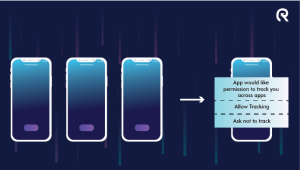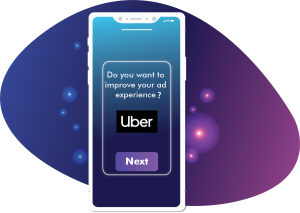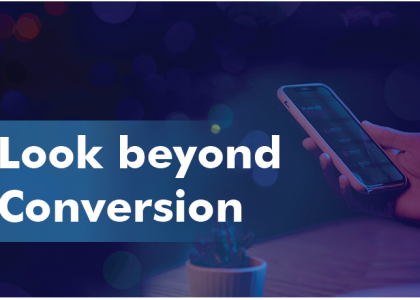How to retarget iOS users in the post-ATT world?
Nearly two years have passed since Apple introduced iOS 14.5, which altered the way iOS app marketers could acquire and target new users on iOS devices. Despite the removal of IDFA by Apple, it remains possible to run successful mobile programmatic retargeting campaigns to retarget high-value iOS users. In this article, we examine how Apple’s decision to deprecate
IDFA has impacted retargeting iOS users and discuss how app marketers can still use alternative methods to run effective retargeting campaigns on iOS.
Before iOS 14.5, Apple provided advertisers with the IDFA, a unique device identifier, which allowed marketers to create targeted advertising campaigns and optimize their ad spend. However, with the introduction of the AppTrackingTransparency (ATT) framework, Apple restricted advertisers’ access to user data, including IDFA. As a result, retargeting campaigns
have become more complicated, and the ability to tie ad impressions to conversions has been
reduced, resulting in a decline in performance and scalability.
After Apple announced its plans to restrict its unique identifier in 2020, the industry reacted with pessimism and concern, fearing that opt-in rates for the App Tracking Transparency (ATT) framework would be as low as 0-20%. However, as iOS 14.5 was released and two years have passed, opt-in rates have turned out to be much higher than expected. According to Statista, as
of March 2022, the overall ATT opt-in rate for iOS users worldwide was 46%, indicating that almost half of all users are willing to share their IDFA for a personalized experience.
In some app categories, such as finance and utilities, the opt-in rate is even higher, with an average of 53% of users consenting to share their IDFA. Therefore, it’s evident that Apple’s ATT framework hasn’t completely undermined app marketers’ ability to retarget their top users as previously thought. With the possibility of retargeting iOS users still available, it’s time for app marketers to shift their focus back to iOS and reconnect with their valuable, high-spending users.
According to AppsFlyer, 80% of apps have implemented the Apple ATT prompt to ask if users consent to share their data. While the majority of app developers are using a prompt, many are still not using a pre-prompt, which is a key strategy for increasing your brand’s opt-in rate, as IOS app marketers.

A pre-prompt is a popup message that apps can show users just before Apple’s ATT prompt. Unlike Apple’s prompt, the pre-prompt gives advertisers more ability to customize copy and design in order to better personalize their opt-in pitch to new users.
User-centric Approach
When creating a pre-prompt, it’s important to focus on a user-centric copy that clearly communicates the benefits of sharing the IDFA. Instead of highlighting what’s in it for your brand, such as the ability to target and track users, emphasize how opting in will enhance the user’s experience. To make sure the message is clear and concise, keep the copy short and sweet.Consider using bullet points to highlight the key benefits of the ask, making it easy to read and understand even if the user is just skimming the text. As shown in the example below from Uber, a clear headline and well-placed call-out bullets can effectively communicate the value of sharing the IDFA with users.
communicates the benefits of sharing the IDFA. Instead of highlighting what’s in it for your brand, such as the ability to target and track users, emphasize how opting in will enhance the user’s experience. To make sure the message is clear and concise, keep the copy short and sweet.Consider using bullet points to highlight the key benefits of the ask, making it easy to read and understand even if the user is just skimming the text. As shown in the example below from Uber, a clear headline and well-placed call-out bullets can effectively communicate the value of sharing the IDFA with users.
Timing is everything
Timing is crucial when it comes to presenting the privacy question to your users. If your app has an onboarding sequence, it’s recommended to display your pre-prompt immediately afterward. This integrates your pre-prompt into your funnel and prevents a separate pop-up window that may be overwhelming for users.
Native and Contextual
Selecting appropriate graphics can enhance the effectiveness of your pre-prompt by ensuring it blends seamlessly with your app’s user experience. For example, Candy Crush, a popular gaming app, uses visually stunning pre-prompts that complement the game’saesthetics and provide a cohesive user experience. iOS app marketers can use this 
strategy to create immersive, streamlined pre-prompts that resonate with their target audience. Additionally, Candy Crush’s pre-prompt includes a message that assures users that they can modify their privacy preferences at any time. This is an effective approach that adds approachability to the message and can be implemented by iOS app marketers to make their pre-prompts more user-friendly. If you’re an app business looking to kick off your growth and retention strategy for 2023, consider investing in retargeting iOS users. Our team of mobile experts is ready to assist you in getting started today.



